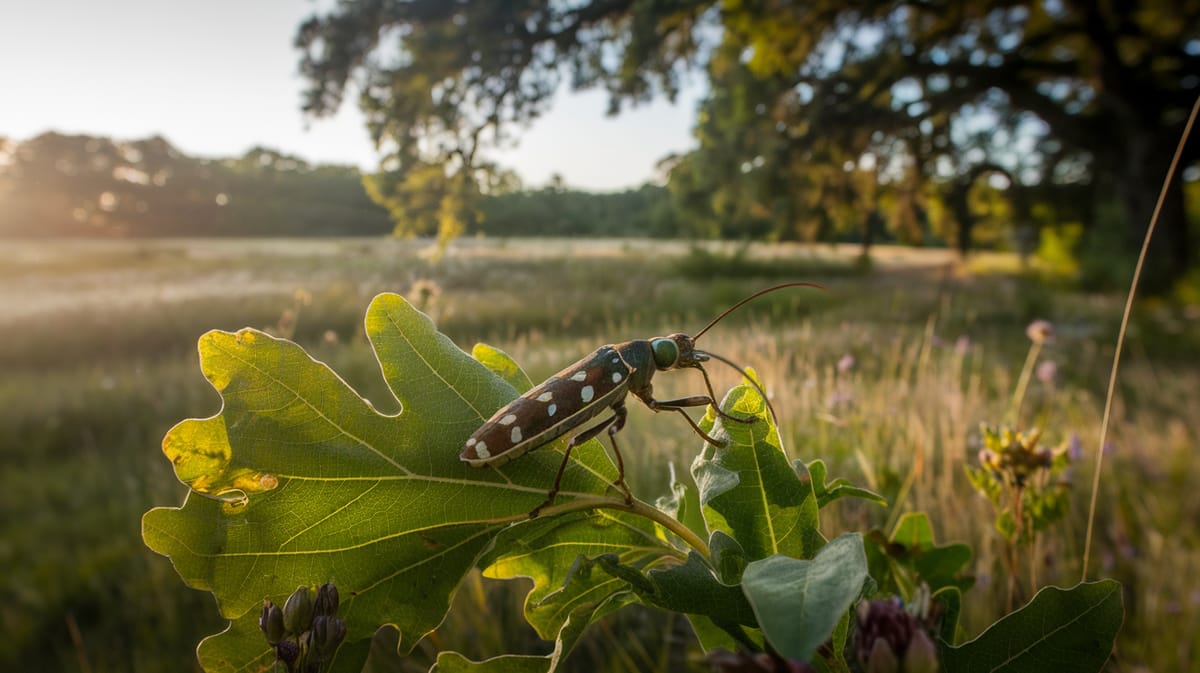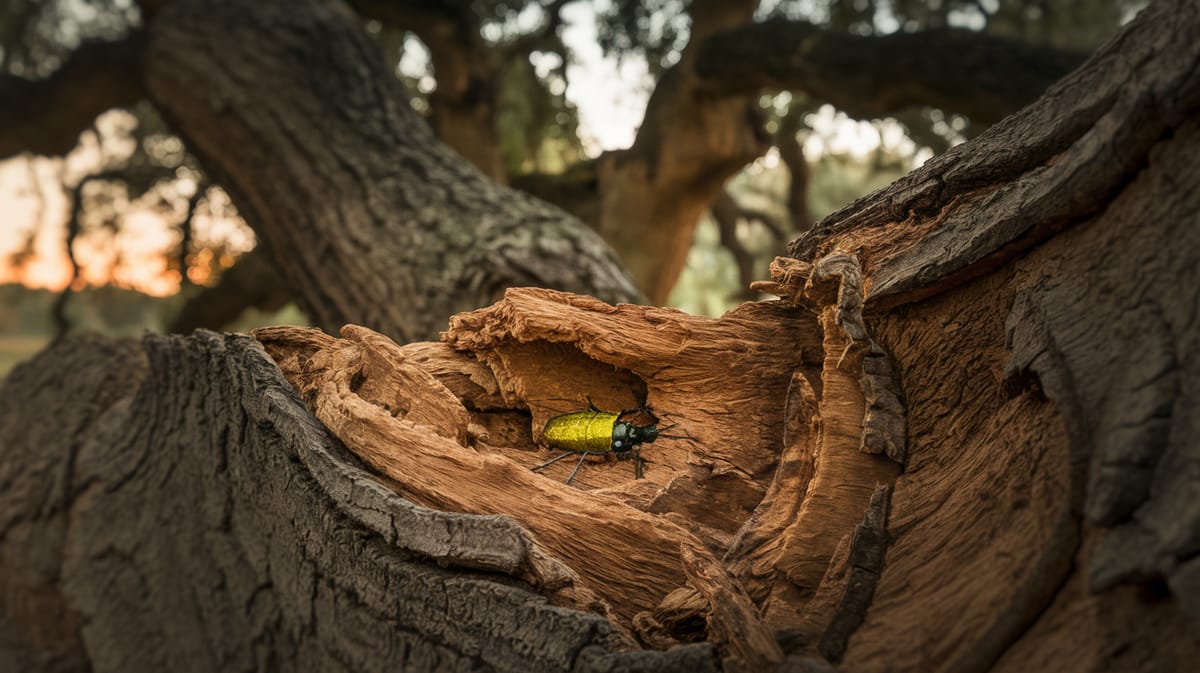Goldspotted Oak Borer
Unique emerald sheen and voracious appetite, the Goldspotted Oak Borer devastates oak trees with silent persistence. Its larvae burrow through bark, disrupting vital nutrient pathways.

Key Insights at a Glance
Did You Know?
Taxonomy & Classification
Goldspotted Oak Borers exhibit unique metallic sheen and larval wood-boring adaptations, playing a crucial role in their ecological niche as oak pests. Let's understand the evolutionary journey and classification of these remarkable herbivores.
Species Diversity
Goldspotted Oak Borers belong to the diverse genus Agrilus, which includes over 3,000 species found worldwide, each with specialized host-plant interactions.
Evolutionary Resilience
Originating over 100 million years ago, Buprestidae have survived major climatic shifts, showcasing adaptability and persistence through evolutionary history.
Lifecycle and Growth
A remarkable journey of transformation from Egg to Adult.
Egg
Females lay eggs in cracks on oak bark where they are sheltered until they hatch into larvae.
Larva
Larvae tunnel under bark, feeding on phloem and cambium, creating distinct galleries that disrupt nutrient flow.
Pupa
Pupation occurs within the tree, where larvae transform into adults, undergoing significant morphological changes.
Adult
Adults emerge from trees, characterized by metallic green bodies, and focus on mating and laying eggs for the next generation.
Dietary Habits
A destructive wood-boring beetle, it primarily feeds on oak tree tissues, causing significant harm to its host trees.
| DIET TYPE | DESCRIPTION |
|---|---|
| Primary Diet | Prefers to consume cambium and phloem layers of oak trees, crucial for tree nutrient transport. |
| Secondary Diet | Occasionally feeds on young sapwood, especially when cambium is less accessible due to environmental or tree condition changes. |
| Occasional | Rarely targets other hardwoods under stress, exploiting weakened trees during drought or infestation events. |

Behaviour and Adaptations
Discover the remarkable capabilities that allow the Goldspotted Oak Borer to thrive in its environment.
Host Detection
Skilled at identifying weakened oak trees to infest and feed.
Larval Burrowing
Larvae create intricate galleries under bark, disrupting nutrient flow.
Rapid Reproduction
High reproductive rate ensures wide infestation spread.
Ecosystem Impact
Understanding how the Goldspotted Oak Borer affects ecological balance.
Nutrient Cycling
Facilitates nutrient cycling by breaking down oak tree wood.
Biodiversity Influence
Creates habitats for other organisms by altering tree structures.
Forest Dynamics
Influences forest composition by selectively targeting oak trees.
Conservation Challenges
Conservation Challenges: Understanding and addressing the major threats to Goldspotted Oak Borer populations.
Habitat Destruction
Deforestation reduces oak tree availability, crucial for the borer's survival.
Climate Change
Temperature changes disrupt life cycles and habitats.
Chemical Exposure
Pesticides harm borers and disrupt ecosystems.
Frequently Asked Questions
How long do Goldspotted Oak Borer live?
Goldspotted Oak Borers typically live for about one year. Their lifecycle includes egg, larval, pupal, and adult stages, with the majority of their life spent as larvae feeding under the bark of oak trees.
What do Goldspotted Oak Borer eat?
Goldspotted Oak Borers primarily feed on the inner bark and cambium of oak trees, particularly coast live oak, canyon live oak, and California black oak. The larvae tunnel under the bark, disrupting the tree's nutrient and water transport systems.
Are Goldspotted Oak Borer poisonous?
Goldspotted Oak Borers are not poisonous. They do not pose a direct threat to humans or animals. Their primary impact is on oak trees, where they cause significant damage through their feeding activity.
Are Goldspotted Oak Borer endangered?
Goldspotted Oak Borers are not classified as endangered. They are considered an invasive species in regions like California, where they have caused extensive damage to native oak populations.
What do Goldspotted Oak Borer symbolize?
Goldspotted Oak Borers do not have any widely recognized symbolic meaning. They are primarily known for their role as a destructive pest to oak trees, impacting forestry and ecosystems.
Do Goldspotted Oak Borer bite?
Goldspotted Oak Borers do not bite humans or animals. Their mouthparts are adapted for feeding on tree bark, not for biting or stinging.
What color are Goldspotted Oak Borer?
Goldspotted Oak Borers are metallic green with distinctive gold-colored spots on their wing covers. This coloration helps them blend into tree bark, making them harder to spot.
Does a Goldspotted Oak Borer have wings?
Yes, adult Goldspotted Oak Borers have wings. They are capable fliers, which aids in their dispersal to new host trees. The wings are metallic green with gold spots.
What does a Goldspotted Oak Borer look like?
Adult Goldspotted Oak Borers are about 10 mm long, metallic green, with six gold spots on their elytra. They have a flattened body and serrated antennae. Their larvae are creamy white and legless, living under the bark.
Is a Goldspotted Oak Borer an insect?
Yes, the Goldspotted Oak Borer is an insect. It belongs to the order Coleoptera, which is the group of beetles. It is specifically part of the Buprestidae family, known for their metallic wood-boring beetle characteristics.
Related Insects
Discover insects with similar characteristics to Goldspotted Oak Borer - including shared habitats, diets, and taxonomic classifications
Share this profile
Help others discover Goldspotted Oak Borer
